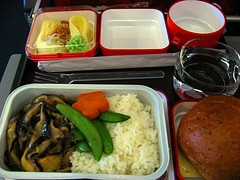Food Safety: How to find the goblins lurking in that airline grub
Health reporters may be entering a season of scary airline food stories.
After years of paying too little attention to the quality and safety of food being served in airplanes, the U.S. Food and Drug Administration has been forced to take the issue more seriously.
Why?
This summer, Gary Stoller at USA Today nailed the airlines and their food service contractors for feeding people food that had been made in unsanitary conditions. Here are a few examples from the paper's investigative report:
An FDA inspector spotted a mouse, rodent nesting materials and rodent feces under a pallet of food and in other areas at LSG Sky Chefs' Minneapolis facility during a May 2009 inspection. The Dulles, Va., facility of Gate Gourmet, the second-largest caterer in the USA, failed to keep shrimp, filet mignon, Chilean sea bass, chicken and vegetables, and pastrami and cheese sandwiches at the proper temperature during an inspection in August.
Employees with "unclean hands" were handling food. A lab report found a "high coliform count" in rice. At Gate Gourmet's San Diego facility in November, the director of operations said the company would cook any food to an airline's specification without regard to food safety guidelines, an FDA inspector wrote. He also wrote that a Gate Gourmet official said the company doesn't verify if food is from approved sources or frozen for "parasite destruction."
Raw meats aren't cooked to adequate temperatures - a repeat violation that was also cited in 2008. A Los Angeles facility of Flying Food Group had a corroded and taped ice-machine door that failed to "hold ingredients in bulk or in suitable containers to protect against contamination," an inspector wrote in an April report.
The story prompted Sen. Charles Schumer to demand that the FDA crack down on airline caterers. And in August, the FDA issued a warning letter to Sun Country Airlines in Minnesota for allowing food to remain at unsafe temperatures for at least four hours.
Here are five tips for finding out whether your local airport has a food monster waiting to come out of one of those tiny airplane closets.
1. Find out who may have insight into your airport. Airports each have different management structures and criss-crossing layers of regulators. Often they are run by the county or by an airport authority. The Federal Aviation Administration has ultimate oversight over the airline traffic itself, but there are dozens of federal, state and county agencies that have their hands in some part of an airport's business.
2. Pay attention to FDA warning letters. Before the USA Today package, media outlets had a field day with a December 2009 warning letter written to LSG Sky Chefs. LSG responded by firing its general manager and head chef at Denver International Airport.
3. Don't assume that no warning letter means no story. USA Today went well beyond the warning letters because most FDA inspections never result in warning letters or fines. It requested "inspection reports since January 2009 for the two biggest airline caterers, LSG Sky Chefs and Gate Gourmet, and a third large caterer, Flying Food Group. Combined, the three companies have 91 kitchens preparing in-flight food for many big U.S. and foreign airlines at U.S. airports." Why not ask for the same reports going back even further?
4. Talk with your county health department. Even if county health inspectors aren't involved in the actual food safety on the airlines, they do receive reports of food borne illnesses at local hospitals and clinics. A Los Angeles County health worker provided key information, for example, in an investigation of an international outbreak of salmonella.
5. Tap outside experts. Inspection reports, warning letters and other documents can be so technical that the news may be hidden behind the jargon. There are experts who specialize in food safety at universities across the country, including Michigan State University's National Food Safety & Toxicology Center.
Have an idea? Write askantidote [at] gmail [dot] com

